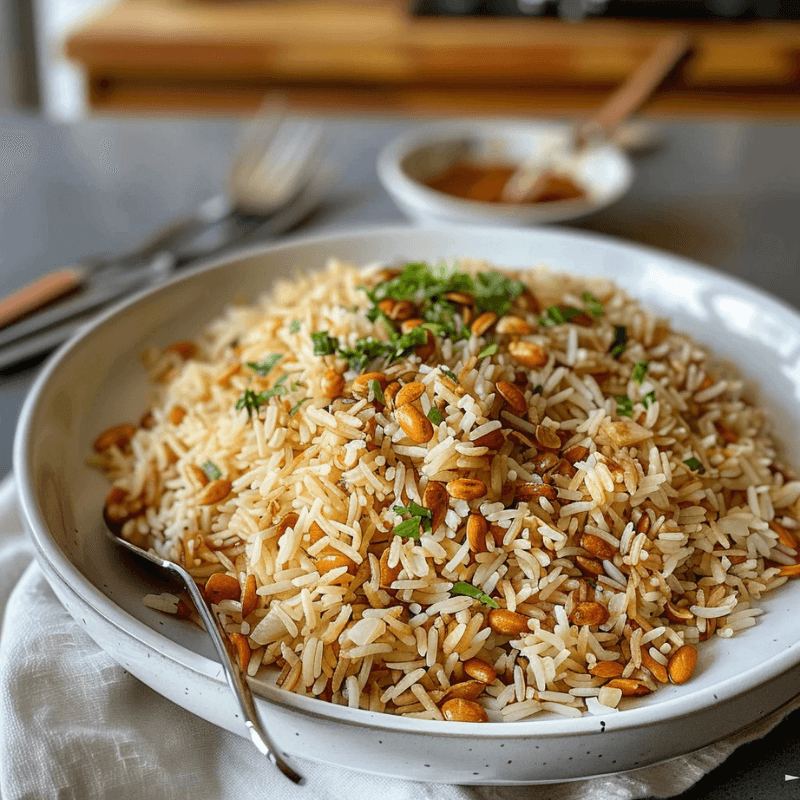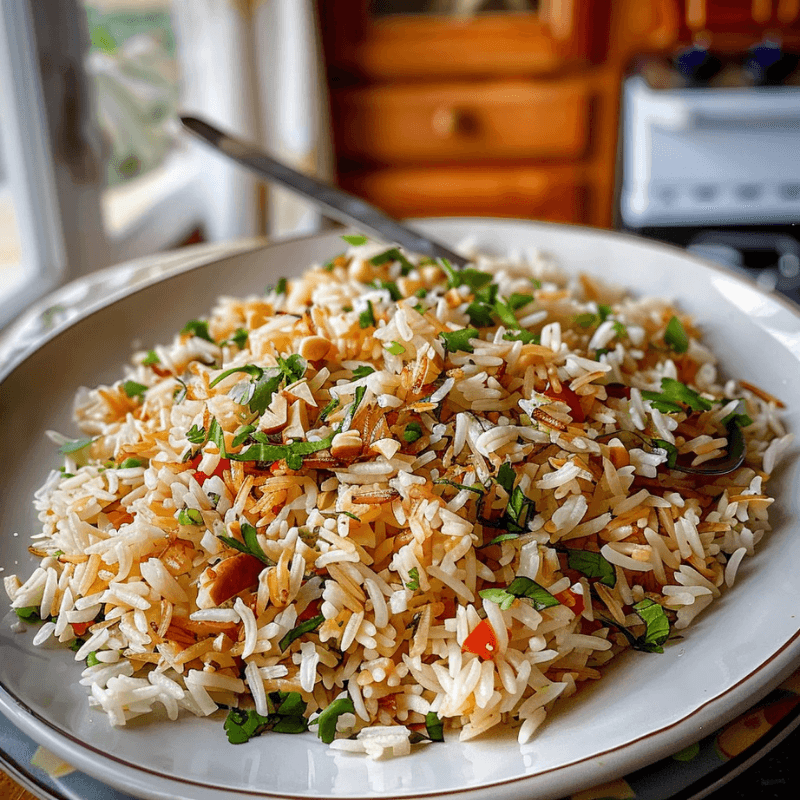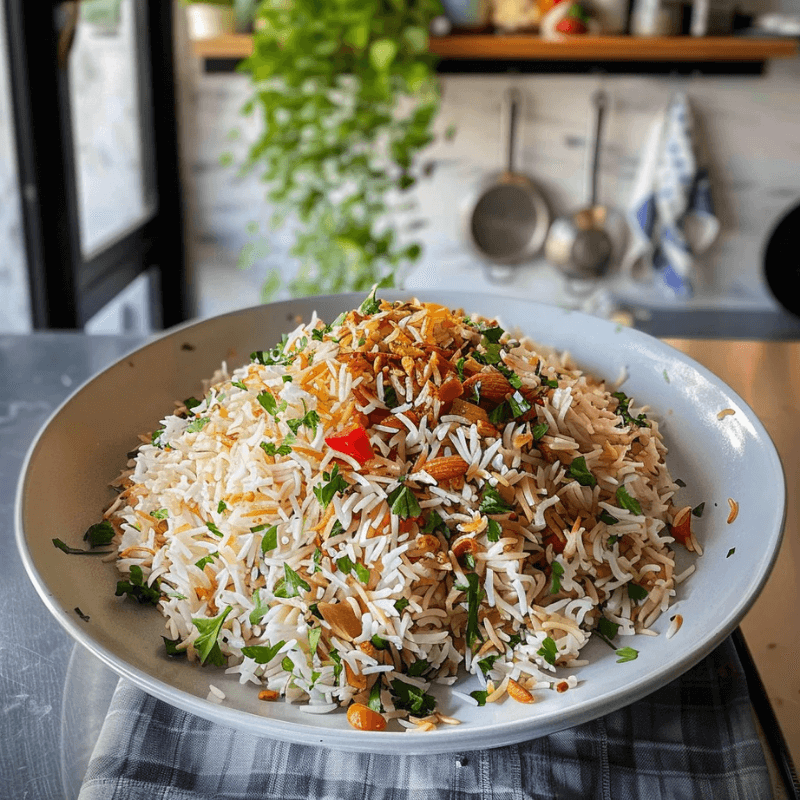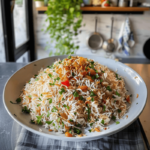Authentic Lebanese Rice recipe might seem deceptively simple, but this iconic dish stands as the most served side dish across the Middle East. While it requires just three main ingredients – long grain white rice, vermicelli noodles, and olive oil or butter – the magic lies in its preparation technique.
I’ve learned that making authentic Lebanese rice with vermicelli isn’t just about combining ingredients. The secret lies in perfectly toasting the vermicelli until golden brown, a technique that transforms this humble Lebanese rice pilaf into something extraordinary. Often served alongside kafta and shawarma, this versatile dish adapts beautifully to both meat-based and vegetarian meals, making it a cornerstone of our family gatherings.
In this guide, I’ll share our treasured family method for creating the perfect Lebanese vermicelli rice, along with the little-known techniques that have been passed down through generations.
The Story Behind Our Family’s Lebanese Rice
Growing up in a Lebanese household, our family gatherings always featured a steaming platter of perfectly cooked vermicelli rice at the center of the table. This wasn’t just a side dish—it represented our heritage, our connections, and our shared history.

How this recipe was passed down through generations
My most treasured childhood memories revolve around our kitchen, where my mother would patiently teach me the art of making Lebanese rice with vermicelli. She learned from her mother, who learned from hers—a chain of culinary knowledge stretching back through generations. “The attributes my mom has passed on to me are legion,” as one Lebanese-American writer perfectly captured it.
For Lebanese families like ours, rice preparation isn’t simply cooking—it’s an inheritance. My grandmother would often say, “When you toast the vermicelli perfectly, you honor those who taught you.” She insisted on watching the golden-brown transformation closely, never stepping away from the stove. This vigilance became almost ritualistic in our home.
What makes our family recipe special are the subtle techniques that don’t appear in cookbooks. My grandmother’s particular method of stirring the rice ensured it wouldn’t stick together. Meanwhile, my mother added her touch—a specific way of covering the pot during simmering that, according to her, “makes all the difference.”
Throughout my childhood, this Lebanese rice recipe appeared “3-4 times a month” on our family table. The frequency with which we prepared it allowed the techniques to become second nature, a culinary language passed through hands rather than words.
Why vermicelli rice is central to Lebanese cuisine
Lebanese rice with vermicelli isn’t just our family tradition—it’s the foundational side dish throughout Lebanon and neighboring countries. Known as “riz bi sha’riyeh” in Lebanese Arabic, this preparation has earned its place as “the most served side dish in that part of the world”.
The origins of this iconic dish trace back centuries to the Levantine region. Consequently, rice cultivation has deep historical roots in Middle Eastern culinary heritage. What transformed this simple grain into something special was the addition of vermicelli—thin noodles that were introduced during the Arab expansion.
Throughout the Middle East, this dish goes by various regional names:
- In Egyptian Arabic: “Rozz be el shyeriyah”
- In Lebanese Arabic: “Rizz bi-sh-shʿayriyyeh”
- In Classical Arabic: “Al-Aruzz bi-sh-shu’ayriyyat”
Furthermore, each region and indeed each family adds their unique touch to the basic preparation. Some incorporate pine nuts and raisins, others add garlic or onions, creating endless variations on the central theme. My grandmother occasionally added mushrooms and scallions to her version, a practice I’ve proudly continued.
The significance of Lebanese vermicelli rice extends beyond its ingredients. This humble dish connects generations, complements virtually every main course, and represents the genius of Lebanese cuisine—transforming simple ingredients into something transcendent. As noted by Lebanese home cooks, it “completes meals” and provides “something so comforting” that it has endured as a cultural touchstone.
Ultimately, our family’s Lebanese rice recipe isn’t just about food—it’s about preservation. Each time I prepare it, I’m participating in a cultural conversation that has continued for centuries, adding my own voice while honoring those who came before.
Essential Ingredients for Authentic Lebanese Rice
The foundation of exceptional Lebanese rice rests entirely on selecting quality ingredients. After decades of preparing this dish, I’ve learned that even slight variations in components can significantly change the final result.

Selecting the right type of rice
The type of rice you choose forms the cornerstone of authentic Lebanese rice pilaf. Traditionally, long-grain rice stands as the preferred option, with basmati rice being my family’s top choice. The reason is simple—basmati produces fluffy, distinct grains that don’t clump together.
Some Lebanese families prefer parboiled rice (like Ben’s converted rice) for its superior texture, although it undergoes more processing. In contrast, jasmine rice isn’t ideal for this dish despite being a long-grain variety. Above all, short-grain rice varieties should be avoided entirely, as they become too sticky for proper Lebanese rice.
First thing to remember, regardless of which rice you select, proper preparation is essential:
- Soak the rice for 15-20 minutes
- Rinse thoroughly until water runs clear
- Maintain the sacred rice-to-water ratio of 1:1.5 (one cup rice to one and a half cups water)
This preparation eliminates excess starch, preventing the grains from sticking together while ensuring even cooking throughout.
Finding the perfect vermicelli
Vermicelli is not just an ingredient—it’s what makes this dish distinctive. These thin, short pasta noodles are so fundamental that the dish is sometimes called “Vermicelli rice” in English or “riz bi sha’riyeh” in Lebanese Arabic.
If vermicelli proves difficult to find, cappellini pasta (thinner than spaghetti) broken into small pieces works as an excellent substitute. The key lies in proper toasting—the vermicelli must reach that perfect golden-brown color that infuses the dish with its signature nutty flavor.
The debate: butter vs. olive oil
In my family, this topic has sparked countless friendly arguments at the dinner table. Traditionally, both butter and extra virgin olive oil have loyal advocates.
Butter delivers a rich, indulgent flavor profile that many find irresistible. Conversely, olive oil provides a lighter touch with its distinctive Mediterranean character. Some families, including mine, use a combination of both—butter for depth and olive oil for authenticity.
Importantly, whichever fat you choose, its primary purpose extends beyond flavor. It coats each grain of rice during the toasting process, preventing clumping and contributing to that distinctively fluffy texture.
Optional aromatics and spices
While the basic Lebanese rice requires only three primary ingredients, thoughtfully selected aromatics and spices can elevate it to new heights.
The legendary seven-spice blend (baharat) appears frequently in Lebanese kitchens. This aromatic mixture typically includes allspice, coriander, black pepper, cardamom, cloves, and nutmeg. Additionally, for those without access to seven-spice, allspice makes a suitable alternative.
Cinnamon deserves special mention—adding two cinnamon sticks to the cooking liquid creates a wonderfully aromatic variation that my grandmother particularly favored. For a more savory dimension, cooking the rice in chicken or vegetable broth rather than water introduces subtle depth without overpowering the dish.
For everyday preparation, even simple seasonings—a pinch of salt and pepper—enhance the natural flavors beautifully. The beauty of Lebanese rice lies in this balance: the simplicity of core ingredients allows for personal expression through carefully chosen aromatics.
The Secret Technique: How to Make Lebanese Rice Perfectly
The technique behind preparing the perfect Authentic Lebanese Rice is what transforms simple ingredients into a magnificent dish. After years of experimenting with different methods, I can confidently say that mastering the fundamental techniques matters more than fancy ingredients.
Toasting vermicelli to the ideal golden brown
The most crucial step in making authentic Lebanese rice is toasting the vermicelli perfectly. Initially, heat oil or butter (or both) in a medium non-stick pot over medium-high heat until hot. Thereafter, add the vermicelli pasta and stir frequently to ensure even browning. This constant attention prevents burning while developing that signature nutty flavor.
What many recipes don’t emphasize is that the color matters tremendously. The vermicelli should reach a deep golden brown – not pale yellow, not burnt. My family’s secret? The darker the color (without burning), the richer the flavor. As one Lebanese cook notes, “Darker color means more flavor”. Nevertheless, once the vermicelli starts changing color, it darkens quickly, so never step away from the pot during this critical phase.
The rice-to-water ratio debate settled
The perfect rice-to-water ratio has sparked endless debates among Lebanese cooks. Throughout my childhood, I watched my mother use the 2:1 ratio (water to rice), yet my grandmother insisted on 1.75:1.
Actually, both work depending on your preference for texture. For fluffier rice where each grain remains separate, the ideal ratio is 1.5:1. Specifically, for one cup of rice, use one and a half cups of liquid. Some expert Lebanese cooks recommend using hot water or broth to maintain the cooking temperature, which I’ve found makes a noticeable difference.
For exceptional results, another technique involves soaking the rice for 20-30 minutes before cooking. This eliminates excess starch and ensures even cooking throughout each grain.
My grandmother’s timing method
My grandmother’s timing technique remains etched in my memory. Primarily, she insisted that perfect Lebanese rice requires three distinct cooking phases:
- The active boil: Bring the water to a full boil with rice and toasted vermicelli
- The gentle simmer: Reduce heat to low, cover, and cook for 15-20 minutes
- The crucial rest: After cooking, leave the pot undisturbed with heat off for 5-10 minutes
This final resting phase is essential yet often overlooked. “You must let the rice rest,” my grandmother would insist. This allows the steam to finish cooking the rice while ensuring the perfect texture. Only after this rest should you uncover and fluff with a fork.
For this reason, I never rush the process. The whole technique—from toasting to resting—creates that distinctive texture where each grain remains separate yet fully cooked, the hallmark of perfect Lebanese vermicelli rice.
Regional Variations of Authentic Lebanese Rice Pilaf
Across Lebanon’s diverse geography, what appears to be a simple vermicelli rice pilaf transforms dramatically based on regional ingredients and family traditions. These variations reveal the dish’s versatility and cultural importance throughout the country.

Northern Lebanon’s mountain style
In Northern Lebanon’s mountainous regions, the traditional Lebanese rice recipe takes on heartier characteristics suited to the cooler climate. Mountain families often incorporate warming spices like cinnamon and seven-spice blend (baharat) into their rice. This gives mountain-style Lebanese rice pilaf a distinctly aromatic profile compared to versions from other regions.
Unlike the coastal areas, Northern Lebanese families frequently enhance their vermicelli rice with pine nuts and sometimes even dried fruits like raisins or golden sultanas. This addition creates textural contrast and subtle sweetness that complements the savory dishes typically served in mountain households.
One notable mountain variation includes the addition of finely chopped gizzards – a practice that speaks to the resourcefulness of Lebanese mountain cooking traditions. This protein-rich addition transforms the rice from side dish to a more substantial offering.
Coastal adaptations with seafood influence
Along Lebanon’s Mediterranean coastline, the iconic Sayadieh represents the most dramatic regional adaptation of Lebanese rice. This coastal variation pairs vermicelli rice with white fish and distinctive spicing. The name itself derives from “sayad,” meaning “fisherman” in Arabic, highlighting its origins in coastal communities.
Unlike inland versions, coastal Lebanese rice preparations often incorporate:
- Cumin as the predominant flavor
- Turmeric for a distinctive yellow color
- Caramelized onions for sweetness
- Fish broth instead of water
What makes this adaptation particularly ingenious is how coastal cooks use the same oil used for frying fish to toast the vermicelli and cook the rice. This technique infuses the entire dish with subtle seafood flavor without overpowering the delicate rice.
How our family recipe differs
My family’s Lebanese rice pilaf reflects our unique culinary heritage. Most distinctively, my mother enhances our vermicelli rice with mushrooms, garlic, and scallions – additions not found in many traditional preparations. These savory elements transform the rice into what we affectionately call “Mom’s Special Rice.”
Through generations, we’ve maintained a preference for cooking our Lebanese rice with a combination of both butter and olive oil, which creates a more complex flavor profile than using either alone. Though seemingly minor, this technique represents years of family kitchen wisdom.
Perhaps most uniquely, where many families consider Lebanese rice solely a side dish, our family treats it as the foundation of our table, sometimes making it the centerpiece by incorporating ground meat or lamb. This elevation of Lebanese vermicelli rice from accompaniment to featured dish represents our family’s particular appreciation for this beloved staple.
Traditional Pairings for Lebanese Vermicelli Rice
Versatile Lebanese vermicelli rice serves as the perfect foundation for countless traditional dishes, making it “the most served side dish in that part of the world”. Primarily acting as a complementary element, this rice pilaf enhances the flavors of numerous Lebanese classics.
Classic meat dishes that complement the rice
Lebanese rice with vermicelli naturally pairs with grilled and roasted meats that showcase the rich culinary traditions of Lebanon. Kafta (spiced ground meat) and shawarma create a harmonious balance with the nutty flavors of the rice. Moreover, Lebanese families frequently serve this rice alongside roasted chicken or chicken kebabs, creating a satisfying meal with contrasting textures.
For special occasions, lamb dishes take center stage alongside vermicelli rice. Traditionally, bone-in lamb shoulder or neck cooked “slow and low, until the meat falls off the bone” creates a melt-in-your-mouth experience. My family reserves this pairing for celebrations like Eid, Christmas, and family weddings—occasions that call for something extraordinary.
Vegetarian options from Authentic Lebanese Rice
Equally impressive are the meatless pairings that showcase how Lebanese vermicelli rice complements plant-based dishes:
- Vegetarian stews featuring green beans or eggplant
- Falafel with its crispy exterior contrasting the fluffy rice
- Lentils and rice dishes that create a complete protein
In Lebanese households, these combinations aren’t merely afterthoughts but carefully planned meals where the rice enhances the vegetable-forward main dishes.
The importance of yogurt as a side
Perhaps the most underappreciated yet essential pairing is plain yogurt. Certainly, “Authentic Lebanese Rice with yogurt” represents a fundamental combination in Lebanese cuisine. Children especially appreciate this simple pairing—”My kids would be happy eating it plain with just some plain yogurt”.
Traditionally, Arab yogurts were made from sheep’s milk in springtime and preserved through salting or drying, creating distinctive sour and salty flavors. Currently, most families use fresh yogurt, which develops a pronounced acidity when cooked. Some families add a pinch of cinnamon to their yogurt, creating a subtle warmth that complements the rice beautifully.
For a complete meal experience, surrounding the vermicelli rice with small sides of hummus, labneh, pickled turnips, and olives transforms a simple rice dish into a feast worthy of any gathering.
Conclusion
Authentic Lebanese Rice stands as more than just a side dish—it represents generations of culinary wisdom passed down through countless family kitchens. Throughout my journey sharing this treasured recipe, I’ve learned that mastering this dish requires attention to subtle details, from selecting premium ingredients to perfecting the golden-brown vermicelli.
My grandmother always said that Lebanese rice tells a story—one of family gatherings, cultural preservation, and time-honored techniques. Whether paired with succulent lamb for celebrations or simply served with tangy yogurt for everyday meals, this versatile dish adapts while maintaining its essential character.
Though regional variations exist across Lebanon, the fundamental elements remain constant: perfectly toasted vermicelli, well-chosen rice, and careful attention to timing and technique. These components, combined with family-specific touches, create something truly special.
Each time I prepare this rice, I feel connected to my heritage and the generations of Lebanese cooks who came before me. Their wisdom lives on through every grain of perfectly cooked rice, every strand of golden vermicelli, and every shared meal that brings families together around the table.

Welcome to HealthyBlog365, your go-to destination for all things food and drink. We believe that every meal is not just a way to nourish your body but also a meaningful connection with yourself and your loved ones.
HealthyBlog365 was created with a mission to inspire healthy living through nutritious meals and refreshing beverages. Here, you’ll discover a treasure trove of creative recipes, kitchen tips, and healthy eating trends tailored to fit modern lifestyles.
 What can you find on HealthyBlog365?
What can you find on HealthyBlog365?
- Delicious and easy-to-make recipes: From simple meals for busy mornings to wholesome dinners for family gatherings, we’ve got you covered for every occasion.
- Nutritious drinks: Explore recipes for juices, smoothies, detox teas, and drinks that cleanse your body, boost your mood, and energize your day.
- Guides on eating habits: Get detailed insights into popular diets like keto, low-carb, and vegetarian-friendly meal plans.
- Kitchen hacks: Discover smart tips to save time, preserve food, and cook more efficiently.
We are committed to providing high-quality content, staying up-to-date with the latest trends, and maintaining a balance between nutrition and flavor.
 Connect with HealthyBlog365 on Social Media
Connect with HealthyBlog365 on Social Media
Join the HealthyBlog365 community on social media platforms to stay updated with our latest posts, watch exciting tutorials, and share your food stories with us:
Facebook: Follow us here to stay updated with our latest posts and join our community.
Instagram: Check us out here for inspiring visuals and ideas.
Pinterest: Pin with us here to save creative ideas you’ll love.
YouTube: Subscribe here for detailed tutorials and exciting videos.
 Thank You for Supporting HealthyBlog365!
Thank You for Supporting HealthyBlog365!
We aim to build a connected community where everyone can share and learn from each other. If you have any questions or suggestions, don’t hesitate to reach out to us via social media or our website.
We hope you have a wonderful time on HealthyBlog365 and find new inspiration for your healthy culinary journey!

Authentic Lebanese Rice
Description
Ingredients
- 1 cup long-grain basmati rice
- 2 cups low-sodium chicken broth
- 1 medium onion finely chopped
- 2 tbsp unsalted butter
- 1 cinnamon stick
- 2 tbsp toasted pine nuts optional
Instructions
- Rinse the basmati rice under cold water until the water runs clear to remove excess starch.
- In a large pot over medium heat, melt the butter and sauté the chopped onion for 3-4 minutes until translucent.
- Stir in the rinsed rice and the cinnamon stick; sauté for another minute to absorb flavors.
- Add the chicken broth, bring it to a boil, then reduce heat to low and cover. Cook for 15-20 minutes or until all liquid is absorbed.
- Remove from heat and let sit covered for 5 minutes before fluffing with a fork. Garnish with toasted pine nuts if desired.
